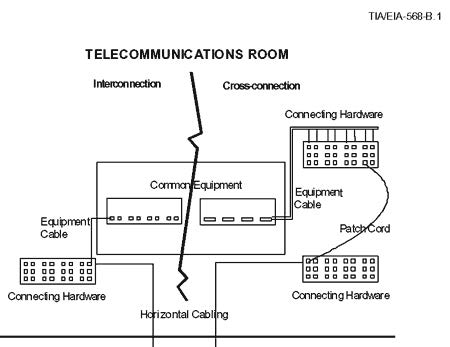Glossary
- Home
- Glossary
- Glossary
- Glossary
- Glossary
- Glossary
- Glossary
- Glossary Technical Information
- Glossary Technical Information
| Cat 3 Cable:The Cat 3 Cable is a UTP (Unshielded Twisted Pair) cable, which reliably carries up to 10 Mbit/s of data. It has a possible bandwidth of 16Mhz. Cat 3 is still mostly in use in two-line telephone systems, but has been mostly superceded by the higher performing Cat 5 standard. Cat 5 Cable:The Cat 5 Cable is a twisted pair cable, mostly unshielded (but there are shielded types.) It is designed for high signal integrity, and can carry up to 155 Mbit/s over short distances. It is used mostly for Ethernet networks, basic voice services and ATM’s,but has been superceded on many industries by the Category 5e specification. Cat 5e Cable: The Cat 5e cable is an enhanced Cat 5 cable, with added specifications for far end crosswalk. With its tighter specifications, it is an excellent choice for 1000BASE-T. Cat 6 Cable: The Cat 6 cable is standard for Gigabit Ethernet and similar network protocols. It is backward compatible with the Category 5 and Category 5e standards. The Cat 6 cable standard delivers a bandwidth of up to 250Mhz. The Cat 6 cable is more effective for system noise and crosstalk. Coaxial Cable: Coaxial Cable is an electrical cable,and consists of a round conducting wire covered by an insulating spacer, which is covered by a cylindrical conducting sheath, lastly covered by a final insulating layer. It is used for high-frequency transmissions and broadband. Structured Cabling: The term structured cabling refers to a cabling infrastructure for a building or campus. It consists of many smaller elements, all standardized according to a specification. These are called subsystems. Non-Plenum: Non-Plenum refers to structured cabling that run between floors (non-plenum areas),and rated more as riser cable. Fiber Cabling: Fiber Fiber Cabling is the term used to refer to structured cabling using the Fiber Optic standard. |
Fiber Optics: Fiber Optics is a loose term that refers to both the applied science and engineering fields that overlap in structuring fiber optic systems using optical fiber. Optical Fiber is very thin plastic or glass fiber wire, made from incredibly pure optical glass,designed to use light to carry digital signals. Network Cabling: Network Cabling is a broad term referring to network or ethernet structures or cabling,for a building, office or campus. RJ 45: The RJ-45 is the standard connector used for Ethernet, T1, ISDN, or 4-pair UTP cables. RJ 11: RJ-11 is the standard connector used for 2-pair (4 wire) telephone wiring. It comes in both UTP or untwisted cable. Ethernet: An Ethernet refers to the various computer networking technologies for a Local Area Network (LAN.) LAN: LAN stands for Local Area Network and refers to a computer network for a small area, such as an office,home or group of buildings. WAN: WAN stands for Wide area Network and refers to a computer network that covers a broad area,where communications can cross national, regional or metropolitan boundaries. MEGABYTE: A unit for measuring computer memory or data storage. A unit of information equal to 1000 kilobytes. GIGABYTE: A unit for measuring computer memory or data storage. A unit of information equal to 1000 megabytes. TERABYTE: A unit for measuring computer memory or data storage. A unit of information equal to 1000 gigabytes. Aramid yarn – Strength element used in cable to provide support and additional protection of the fiber optic cable bundles. Kevlar is a particular brand of Aramid yarn. |
AM – Amplitude Modulation. ATM – Asynchronous Transfer Mode. This is a new emerging data standard (protocol) that uses many of the same data rates as Fiber Channel and SONET. Attenuation – In fiber optic cable, attenuation results from absorption, scattering and other radiation losses. It is usually expressed as decibels per kilometer (dB/km) without the negative sign. Calculations and equations involving loss show and use the negative sign. Attenuator – A passive optical component that intentionally reduces the optical power propagating in a fiber optic cable. Balanced – Signaling code with an equal number of high and low states. Bandwidth – The information capacity of a fiber optic cable. Precisely it is usually measured in GHz (1Billion Hz). Occasionally it is idiomatically discussed in terms of the data transmission rate- the BPS- the actual GHz bandwidth can support. In some contexts it is expressed as MHz-km and denotes the analog bandwidth capability of digital transitions per second that a fiber optic cable can sustain over a 1-km distance. Occasionally the bandwidth of a light source is referred to. This is the width of the spectrum emitted. Baseband – A method of communication in which a signal is transmitted at its original frequency rather than being impressed upon a carrier frequency. Baud – A unit of data transmission signaling speed -data transmission rate - equal to the number of signal symbols per second. With binary modulation systems this is the same as the data transmission rate in Bits Per Second. However, it is different with non-binary modulation systems. Bend loss – A+ form of increased attenuation caused by allowing high order modes to radiate from the walls of a fiber optic cable. There are 2 common types of bend losses. The first type results when the fiber optic cable is curved through a restrictive radius or curvature. The second type is generally referred to as microbends. It is caused by small distortions of the fiber optic cable imposed by externally induced perturbations as, for example, slip shod cabling techniques. Amplitude Modulation – A transmission technique in which the amplitude of a carrier is varied in sympathy with the information being communicated. Plenum Cabling: The term plenum cabling refers to structured cabling laid in the plenum of buildings (the space where air circulation, heating and air conditioning systems are facilitated.) It has a slowburning,fire-resistant casing. Analog – A format that uses continuous physical parameters to transmit information. Examples of parameters are voltage amplitude and carrier frequency. |
| Bend radius – Radius a fiber optic cable can bend before the risk of breakage or increase in attenuation.Also referred to as cable bend radius. Bit – A binary digit which is generally either ‘0’ or ‘1.’It is the smallest representation of information in a communications and/or computing system. Bit rate – The number of bits of data transmitted per second over a communications link. This usually represented as BPS with KBPS standing for kilo bits per second (1000 BPS) and MBPS standing for mega bits per second (million BPS) and GBPS standing for giga bits per second (billion BPS) etc. Broadband – A method of communication in which the signal is transmitted by being impressed on a higher frequency carrier. Also the ability of a communications system to carry a multitude of signals simultaneously. In data transmission is denotes transmission facilities capable of handling frequencies greater than those for high-grade voice communications. The higher frequency allows the carrying of several simultaneous channels. Broadband infers the use of a carrier signal rather than direct modulation, baseband. Buffer – protective layer over the fiber optic cable,such as a coating, an inner jacket, or a hard tube.The primary buffer, next to the cladding, is 250 m in diameter. A secondary buffer of 900 m is used on indoor cables. Buffer coating – A protective layer, such as an acrylic polymer, applied over the fiber optic cable cladding. Buffered fiber – Fiber optic cable protected with an additional material, usually hytrel or nylon, to provide ease in handling, connectorization and increased tensile strength Buffering – It is used in 2 contexts. First, it refers to a protective material extruded directly on the fiber optic cable coating to protect it from the environment.Secondly, it refers to extruding a tube around the coated fiber optic cable to allow isolation of the fiber from stresses. Building entrance – Terminal cable entrance point where typically a trunk cable between buildings is terminated and fiber is then distributed through the building. Dielectric – Non-metallic and therefore nonconductive. Glass fiber optic cable is therefore considered dielectric. A dielectric cable contains no metallic components. |
Bus network – A network topology in which all of the terminals are attached to a transmission medium serving as a bus. All other terminals receive all signals transmitted from a terminal connected to the bus. Bus – Commonly called data bus. The term is used to describe the physical linkage between stations on a network sharing a common communication. Byte – A unit of 8 bits. Cable – Alternate name for fiber optic cable. An assembly of optical fibers (the glass or plastic basic waveguide) and other material providing mechanical and environmental protection and optical insulation of the inner optical waveguide. Cable assembly – Fiber optic cable that has connectors installed on one or both ends. General use of these cable assemblies includes the interconnection of multi-mode and single-mode fiber optic cable systems and opto-electronic equipment. If connectors are attached to only one end of the cable, it is known as a pigtail. If connectors are attached to both ends, it is known as a jumper. Cable bend radius – During installation this infers that the cable is experiencing a tensile load. Free bend infers a lower allowable bend radius since it is at a condition of no load. Channel –A communications path derived from a specific transmission medium, as for example fiber optic cables. The channel supports the endto-end communications of an information source and destination. Besides the transmission medium a channel needs to have a transmitter/receiver (transceiver) and a modulator/demodulator (modem).By multiplexing, several channels can share the same specific transmission medium. Channel is synonymous with link. The term channel is usually employed within the context of multiplexing- but not always. Cladding – A low refractive index glass or plastic that surrounds the core of the fiber optic cable. Optical cladding promotes total internal reflection for the propagation of light in fiber. The cladding steers light to the core. Cleaving –The controlled breaking of a fiber so that its end surface is smooth. Coating – A material put on a fiber optic cable during the drawing process to protect if from the environment. Connector insertion loss – See Insertion Loss. dB loss budget – The amount of light available to overcome the attenuation in the fiber optic data link and still maintain BER (or equivalent) performance specifications. |
Connector – A mechanical device mounted on the end of a fiber optic cable, light source, receiver or housing that mates to a similar device. It allows light to be coupled, optically, into and out of a fiber optic cable.A connector allows a fiber optic cable to be connected or disconnected repeatedly from a device. Commonly used connectors include FC/PC, Biconic, SC, ST, D4,and SMA 905 or 906. Core – The central, light carrying, part of a fiber optic cable. It has an index of refraction higher than that of the surrounding cladding. Coupler – It is used in 2 contexts. First, it is a passive device that distributes optical power among 2 or more ports and this can be in different ratios. Secondly, it is a multi-pod device used to distribute optical power. Coupling losses – The power loss suffered when coupling light from one optical device to another. There are intrinsic losses (non-ideal fiber parameters) and extrinsic losses (mechanical effects). Crosstalk – The pickup in one particular fiber optic cable of unwanted light from another fiber optic cable. CSMA/CD – Carrier Sense Multiple Access with Collision Detection. dB – Decibel, a measure of loss or equivalently attenuation. It is computed as a standard logarithmic unit for the ratio of 2 powers, voltages or currents. In fiber optics the ratio is power and defined by: dB = 10 Log10 (P1/P2). Detector – A device that generates an electrical signal when illuminated by light. The electrical current is dependent upon the amount of light received. Common detectors encountered in fiber optic data communications are photodiodes, photodarlingtons and phototransistors. |
Dispersion – A general term for those phenomena that cause a broadening or spreading of light as it propagates down a fiber optic cable. This is the major cause of bandwidth limitations with fiber optic cable. There are 3 types of dispersion- modal, material and waveguide. Differential optical path lengths in multimode fiber optic cables cause modal dispersion. Material dispersion is caused by a differential delay of various wavelengths of light in a waveguide material. Waveguide dispersion is caused by light travelling in both the core and cladding materials in single-mode fiber optic cables.
Fiber optic link – Any transmission channel using a fiber optic cable as the transmission medium to connect 2 end terminals or to be connected in series with other channels.
Duplex operation – Transmission on a data link in both directions. Half duplex refers to such transmission, but in a time-shared mode- only one direction can transmit at a time. With full duplex there can be transmission in both direction simultaneously.
EIA – Electronics Industries Association. A standards association that publishes test procedures.
EMC – Electromagnetic compatibility
EMI – Electromagnetic interference. It is any electrical or electromagnetic interference that causes an undesirable response, degradation or failure in electronic equipment. Fiber optic cables neither emits nor receives EMI.
Encoding – A scheme to represent digital ones and zeros through combining high and low voltage states.
End to End Loss – The optical loss on an installed fiber optic cable data link path. This loss consists of the loss due to the fiber optic cable, splices and connectors.
FC – A connector type. It is utilized for single-mode fiber optic cable. It offers extremely precise positioning of the single-mode fiber optic cable with respect to the emitter and detector. It features a position locatable notch and a threaded receptacle. Once installed, the
Duplex cable – A 2 fiber cable suitable for duplex (2 way) transmission.
FDDI – Fiber Distributed Data Interface. A very highspeed local area networking architecture based upon fiber optic cable as the transmission medium. Many FDDI features were incorporated into Fast Ethernet-100Base-T. FDDI has its own special type of connector.
Fiber – Thin filament of glass. An optical waveguide consisting of a core and a cladding which is capable of carrying information in the form of light.
Fiber bandwidth – The lowest frequency at which the magnitude of the fiber transfer function decreases to a specified fraction of the zero frequency value. Often the specified value is ?of the value of the transfer function at zero frequency.
Fiber channel – An industry standard specification for computer channel communications over a fiber optic cable. It offers data transmission speeds from 132 MBPS to 1,062 MBPS and transmission distances for 1 to 10 km
Fiber loss – The attenuation (deterioration) of the light signal in transmission through a fiber optic cable.
Fiber optic waveguide – A relatively long strand of transparent substance, usually glass, capable of conducting an electromagnetic wave of optical wavelength (visible or near visible region of the frequency spectrum) with some ability to confine longitudinally directed, or near longitudinally directed, lightwaves to its interior by means of internal reflection. The fiber optic waveguide may be homogeneous or radically inhomogeneous with step or graded changes in its refractive index. The indices are lower at the outer regions and the core is thus of an increased refractive index..
Fusion splicing – A permanent joint accomplished by the application of localized heat sufficient to fuse or melt the ends of the fiber optic cable. This process forms a single continuous fiber optic cable.
Fusion splice – A joining of 2 fiber optic cables by physically fusing through heat the 2 fiber optic cable ends.
GHz – Giga Hertz, 1 Billion Hz.
Hertz – A unit of frequency equal to 1 cycle per second.
Hybrid cable – A cable composed of both a fiber optic cable and electrical conductors. Synonym for composite cable.
IEC – International Electrical Commission
IEEE – Institute of Electrical and Electronics Engineers.
77 – The designation for electromagnetic waves at wavelengths between the visible part of the spectrum (approximately 750 nm) and the microwave band (approximately 30 mm).
Insertion loss – The loss in the power of a signal that results from inserting a passive component into a previously continuous path. Examples of such passive devices are connectors, inline star couplers and splices.
Fiber optics – Light transmission through optical fibers for communication or signaling.
Interface – The debarkation point or location on a data device where data comes out of or goes into the device. Examples are the RS-232 interface and the Mouse-PC interface.
IR – Infrared.
ISDN – Integrated Services Digital Network. A TELCO offering to allow computers to communicate through the telephone Wide Area Network at speeds up to 128 KBPS.
ISO – International Standards Organization. This is an independent international body formed to define standards for multi-vendor network communications. Its 7 layer Open Systems (OSI) reference model defines the protocol layers of network architectures which vendors should account for in their product offerings.
Kilo Hertz (KHz) - 1,000 Hz.
LAN - Local Area Network. This is a geographically limited data communications network. It is often referred to as premises data communications network. Its extent is usually limited to the office building,campus or manufacturing plant - several 1,000 feet.
Laser - An acronym for Light (by) Amplification (by) Stimulated Emission (of ) Radiation. This is a device,which artificially generates coherent light within a narrow range of wavelengths. Lasers can be made to operate in a number of different ways. In one mechanism the molecules of some material are put at higher energy levels. When light is then incident upon the material the molecules make transitions to lower energy levels. The correspondingly released energy is realized as coherent light. Lasers are used as the transmitting source for fiber optic cables when transmission distances are long. Laser light denotes light generated by a laser.
Light - In the laser and optical communication fields is that portion of the electromagnetic spectrum that can be handled by the basic optical techniques used for the visible spectrum extending from the near ultraviolet region of approximately 0.3 mm through the visible region into the mid-infrared region of approximately 30 mm.
Light source - Source of light, which is usually modulated and terminated over a fiber optic cable. It is typically an LED or LD.
Link - A fiber optic cable with connectors attached to a transmitter (source) and receiver (detector).
Local Area Network - See LAN.
Loose tube - A protective tube loosely surrounding a fiber optic cable often filled with a water blocking gel.
Loss - Attenuation of optical signal. It is usually measured in dB.
Mechanical splice - A splice in which fiber optic cables are joined mechanically for example by being glued or crimped in place. However, they are not fused together.
MHz. - Mega Hertz, 1 million Hz.
Micrometer - 1 millionth of a meter, abbreviated mm. Also referred to a micron.
MMF - Multi-mode fiber optic cable.
Optical fiber - Synonym for fiber optic cable.
Modes- In guided wave propagation, such as that through fiber optic cable, it is the distribution of electromagnetic energy that satisfy Maxwell’s equations and boundary conditions. Specifically, applied to optics and transmission down a fiber optic cable a mode is loosely equivalent to a light ray of classic ray optic theory. Sometimes used to denote a light path through a fiber optic cable.
Modulation- The process by which the characteristic of one wave (the carrier) is modified by another wave (the information signal). Examples include amplitude modulation (AM), and frequency modulation (FM).
Multi - mode fiber optic cable - Type of fiber optic cable that support more than 1 propagation mode.
Multiplexing - The process by which 2 or more signals are transmitted over a single transmission medium. Examples include Time Division Multiplexing (TDM) and Wavelength Division Multiplexing (WDM).
NA- Numerical Aperture - The light gathering ability of a fiber optic cable. This defines the maximum angle to the fiber optic cable axis at which light will be accepted and propagated down the fiber optic cable. NA= SIN , where is the acceptance angle. NA is also used to describe the angular spread of light from the central axis - as in exiting from the fiber optic cable, emitting from a source of entering a detector.
Numerical Aperture - See NA-Numerical Aperture. This is the imaginary cone which defines the acceptance area for the fiber optic cable core to accept light rays.
Optical fiber coupler - This is used in 2 contexts. In the first it refers to a device whose purpose is to distribute optical power among 2 or more ports. In the second it refers to a device whose purpose is to couple power between a fiber optic cable and a source or detector.
OTDR- Optical Time Domain Reflectometer. A method of characterizing a fiber optic cable wherein an optical pulse is transmitted down the fiber optic cable and the resulting backscatter and reflections are measured as a function of time. The OTDR is useful in estimating the attenuation coefficient as a function of distance and identifying defects and other localized losses.
Patch Panel- Distribution area to rearrange fiber optic cable connections and circuits. A simple patch panel is a metal frame. One side of the panel is usually fixed. This means that the fiber optic cables are not intended to be disconnected. On the other side are plugs to connect other fiber optic cables.
PE- Polyethylene. This is a type of plastic material used to make cable jacketing. Pigtail- A short length of fiber optic cable,permanently fixed to a component. It is used to couple power between the component and the fiber optic cable used for transmission.
PIN- Positive intrinsic negative photodiode.
Plenum cable - Fiber optic cables whose flammability and smoke characteristic allows it to be routed in a plenum area without being enclosed in a conduit.
Point-to-Point - A fixed link secured between 2 distinct nodes or stations in a network.
Polishing - Preparing the end of a fiber optic cable by moving the end over an abrasive material.
PVC - Polyvinyl Chloride. Material used in manufacture of a type of jacketing material.
Receiver - In the context of a fiber optic cable based communications link it is an electronic package, which converts optical signals to electrical signals.
Reflectance - Light that is reflected back along the path of transmission, from either the coupling region,the connector or the terminated fiber optic cable.
Reflection - The abrupt change in direction of light as it travels from one material to a dissimilar material. Some of the reflected power gets transmitted back to the source.
Refraction - The bending of a beam of light at an interface between 2 dissimilar media or a medium whose refractive index is a continuous function of position (i.e. a graded index medium).
Refractive Index - The ratio of the velocity of light in a vacuum to its velocity in the medium. It is a synonym of index of refraction. Its symbol in ‘n.’
Repeater - An optoelectronic device that amplifies or boosts a signal. Basically, it returns a signal to its original strength.
| Return loss - Same as reflectance. Return reflection - Reflected optical energy that propagates backward to the source in a fiber optic cable. Return reflection loss - The attenuation of reflected light. High return loss is desirable, especially in singlemode fiber optic cables. Riser - Application for indoor cables that pass between floors. It is normally a vertical shaft or space. SC - A connector type. It is primarily used with singlemode fiber optic cables. It offers low cost, simplicity and durability. Furthermore, it provides for accurate alignment by a ceramic ferrule. It is a push on -pull off connector with a locking tab. It is similar to the connector used for FDDI but is not compatible. Simplex - Transmission in only 1 direction. Simplex cable - A term sometimes used for a singlefiber cable. Single-mode - A small core, fiber optic cable that supports only 1 mode of light propagation above the cutoff wavelength. Typically, the diameter of the core is 9-10 m. Dispersion and power loss through the cable walls are low with this type of cable. It is proper for long distance transmission. Source - There is 2 possibilities. First, it is a generator of information or data. Secondly, within the context of fiber optics it is a light emitter, either an LED or laser diode, for a fiber optic cable based link. Splice - An interconnection method for joining the ends of 2 fiber optic cables in a permanent or semipermanent fashion. Thermal fusing may carry out splicing or it may be mechanical. | Splicing - The permanent joining of fiber optic cable ends to identical or similar fiber optic cables without using a connector. See also Fusion splicing and Mechanical splicing. Splice box - Housing for 1 or more splice organizers. The changeable front panel can be equipped with different connector plugs. Splice closure - A container used to organize and protect splice trays. Splice organizer - An organizer panel that holds up to 12 splices with splice protectors and sufficient loops. ST - A keyed bayonet connector type similar to a BNC connector. It is used for both multi-mode and singlemode fiber optic cables. Its use is wide spread. It has the ability both to be inserted into and removed from a fiber optic cable both quickly and easily. Method of location is also easy. There are 2 versions ST and ST-II. These are keyed and spring loaded. They are a push in and twist type. Throughput loss - In a fiber optic cable coupler it is the ratio of power at the throughput port to power at the input port. Tight buffer - Type of cable construction whereby each glass fiber optic cable is tightly buffered by a protective thermoplastic coating to a diameter of 900 microns. High tensile strength rating achieved, providing durability, ease of handling and ease of connectorization. Token ring - A ring based networking scheme. A token is used to control access to the network. Used by IEEE 802.5 and FDDI. Transceiver - A combination of transmitter and receiver providing both output and input interfaces with a device. Transmission loss - Total loss encountered in transmission through a system. Transmitter - In the context of a fiber optic cable based communication link an electrical package, which converts an electrical signal to an optical signal. |
Structured Cabling System (SCS) is based on following a standard methodology defined by EIA/TIA 568 specifications when planning and installing network cabling for commercial buildings. The purpose of this standard is to specify a generic telecommunications cabling system for commercial buildings that will support a multi-product, multivendor environment. It also provides information that may be used for the design of telecommunications products for commercial enterprises.
The EIA/TIA-568 standard includes EIA/TIA-568-B.1 General Requirements, EIA/TIA- 568-B.2 Copper Cabling Requirements, EIA/TIA-568-B.3 Fiber Cabling Requirements.
EIA/TIA-568-B.1 General Requirements
Requirements are defined for the following areas of the Telecommunications Cabling
System Structure (see Figure 1)
- 1. Horizontal cabling
- 2. Backbone cabling
- 3. Work Area
- 4. Telecommunications Room
- 5. Equipment Room
- 6. Entrance Facilities
This structure is designed to support voice, data, text, video and image services. A definition of terms is included at the end of this discussion.
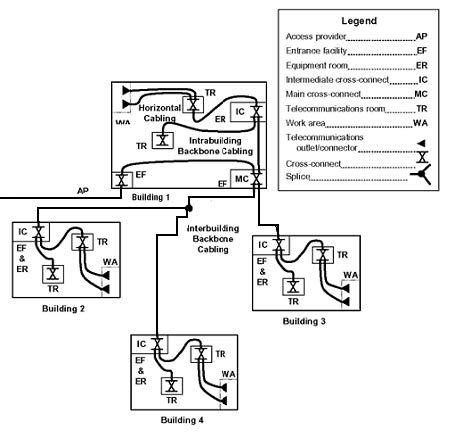
Horizontal Cabling
The horizontal cabling is the portion of the telecommunications system that extends from the work area to the telecommunications room. The horizontal cabling includes horizontal cable, telecommunications outlet/connectors in the work area, mechanical terminations, and patch cords or jumpers located in the telecommunication room, and may include multi-user telecommunication outlet assemblies and consolidation points. The telecommunications room should be located on the same floor as the work area served.
Figure 2 illustrates a typical horizontal cabling run.
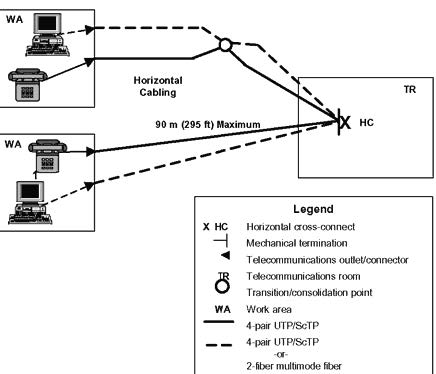
The maximum distance a horizontal run can be is 90 meters (295 feet). The longest a patch cord can be is 5 meters (16 feet). And the longest total length of patch cords on both ends can be 10 meters (32 feet).
The cables recognized by EIA/TIA include:
- 1. Four-pair 100ohm unshielded twisted pair (UTP) or screened twisted pair (ScTP) cables as defined in EIA/TIA-568-B.2
- 2. Two or more optical fiber multimode cable, either 62.5um or 50/125 um per EIA/TIA 568-B.3.
- 3. From the horizontal cross-connect there shall be no more the one additional crossconnect to reach the main cross-connect.
The standard also recommends that there “shall” be at least 2 connectors for each work area; one Category 3 or and the other number 1 or 2 above to support LAN services. Backbone Cabling
The backbone cabling shall use the hierarchical star topology as illustrated in Figure
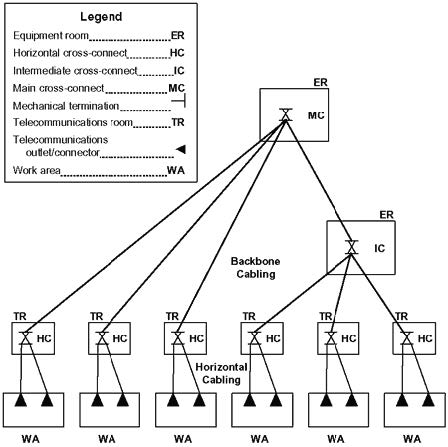
The cables used depend on the application Figure 4 list the maximum distance requirements for the various cable runs. Note that the distances listed for twisted pair cable is for supporting telephone use. To support higher network speeds the 90 meter UTP length still applies back to the main cross-connect.

In the main cross-connect, jumper or patch cord lengths should not exceed 20 m (66 ft).Same for the intermediate cross-connect.
The length of the cable used to connect telecommunications equipment directly to the main or intermediate cross-connect should not exceed 30 m (98 ft).Work Area
The work area includes the telecommunications outlet/connector end of the horizontal cabling system to the work station equipment.
The work area outlet is either in the form of a faceplate or a box. Its primary purpose is to hold the connector or modular jack. Per the standard each 4-pair cable shall be terminated in an eight-position modular jack per EIA/TIA-568-B.2 and IEC 60603-7.
There are two cabling schemes approved, T568A and T568B (see figure 5).
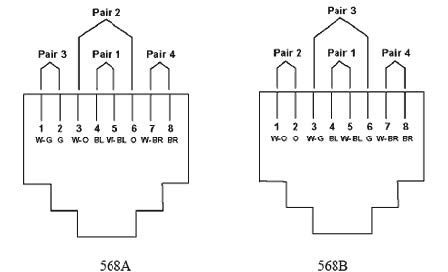
For fiber cabling these shall be terminated to a duplex optical fiber connector meeting the requirements of EIA/TIA-568-B.3. The SC connector is preferred by EIA/TIA but others can be used such as the ST and various small form factor connectors.
MUTOA (Multi-user telecommunications outlet assembly)
This was added to the standard to address the growing use of modular furniture in the commercial office. It provides a more flexible wiring means that facilitates changes easier. See figure 6. It also complicates things a bit, but as long as you follow the guidelines of Figure 7 you will stay compliant. It is limited to serving a maximum of 12 work areas. It shall also be located in a fully accessible permanent location, and not in ceilings.

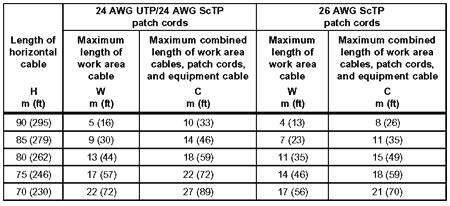
Consolidation Point
It is an interconnection point within the horizontal cabling using the appropriate compliant
connecting hardware, including the requirements of being rated for at least 200 cycles of connections. It also cannot be located within 15 m (49 ft) of telecommunications room as it can cause cabling performance degradation due to reflections.
The Consolidation Point may be useful when reconfiguration is frequent, but not so frequent as to require the flexibility of the MUTOA.
The Telecommunications Room
The primary function of a telecommunications room is the termination of horizontal and backbone cable to compatible connecting hardware. All connections between horizontal and backbone cables shall be cross-connections. Equipment cables/cords that extend a single port appearance may connected through
